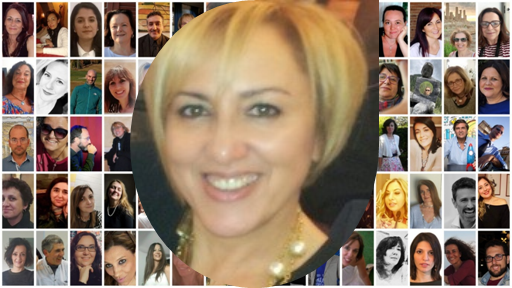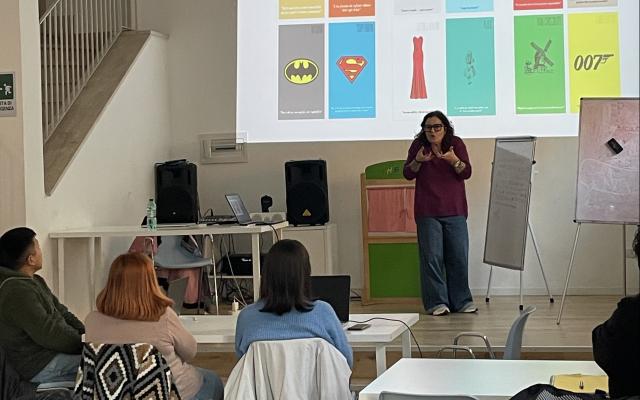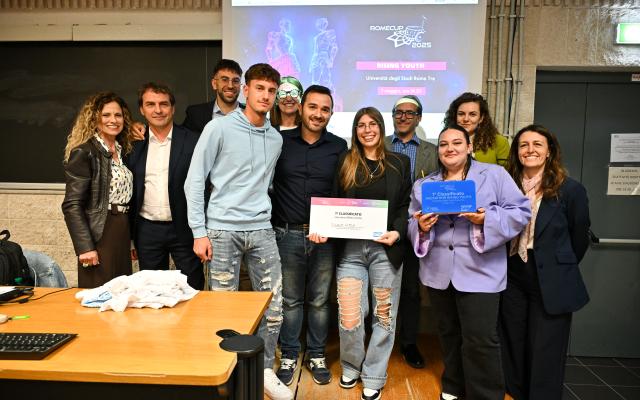This is our fourth weekly instalment of interviews with teachers in Project “Our School” who we have described as i-Teachers, inclusion teachers, who work day in and day out to make sure that no one is left behind [see news: Our School].
Today, a short video and an interview with Ilaria Gaudiello will introduce us to Maria Cristina Bevilacqua, digital coordinator and a teacher deep, down, inside.
 Maria Cristina Bevilacqua is a Professor of Foreign Language at the Istituto di Istruzione Superiore IPSSEOA in Ceccano (FR). She has been described as a teacher deep, down, inside, although for over ten years, she has been a professor. She is curious, enthusiastic and has continued updating her competences. As an eTwinning Ambassador, she 16 active international mobility experiences. As digital coordinator, she has been working on national and international projects since 1988. She has translated “Padagogy Wheel” by Allan Carrington. Moreover, she is a MIEExpert, a Google Certified Educator (L.1) and was selected by MIUR for the local training teams to support the PNSD. She also is a TFA tutor and NEV Area Centro expert. As a member of the ANFIS Directive, she was also the winner of the Pestalozzi Programme and a tutor at the IUL University for the course on “IT Abilities.”
Maria Cristina Bevilacqua is a Professor of Foreign Language at the Istituto di Istruzione Superiore IPSSEOA in Ceccano (FR). She has been described as a teacher deep, down, inside, although for over ten years, she has been a professor. She is curious, enthusiastic and has continued updating her competences. As an eTwinning Ambassador, she 16 active international mobility experiences. As digital coordinator, she has been working on national and international projects since 1988. She has translated “Padagogy Wheel” by Allan Carrington. Moreover, she is a MIEExpert, a Google Certified Educator (L.1) and was selected by MIUR for the local training teams to support the PNSD. She also is a TFA tutor and NEV Area Centro expert. As a member of the ANFIS Directive, she was also the winner of the Pestalozzi Programme and a tutor at the IUL University for the course on “IT Abilities.”

INTERVIEW
Maria Cristina, curiosity and a desire to continuously improve your teaching seem to be your driving force. What does teaching mean to you?
Teaching, as a teacher and as an educator, means exercising a transformative action: soliciting reflection, allowing those learning to participate actively in developing their knowledge, keeping in mind not only the given subject, but also all metacognitive aspects. This means stimulating and reinforcing motivation, focusing also on social and emotional learning. It aims to allow students to discover their talents and exploit them for groupwork. I try to disrupt the determinism that negatively conditions colleagues and students on their roles, cognitive and work styles, and potential, strengths and weaknesses to transform them into opportunities. I do not always succeed, but when I do it’s very satisfying for my students, no matter their age.
You won the Pestalozzi Programme. How have digital tools allowed you to forge traditional and innovative educational methodologies?
In a certain sense, the Pestalozzi Programme was a turning point in my career. It drove me, for example, to overcome my resistance to social networks such as Facebook (that I used for group interaction during the programme work) and allowed me to discover its enormous potential as a place to meet people, exchange views, debate, but also share virtual and virtuous practices that are fertile and enriching with my community of colleagues. The Pestalozzi Programme also allowed me to come into contact with the school system in Finland and the important and delicate issues it addressed such as citizenship and bullying, when these two issues had not emerged yet in Italy. As an eTwinning Ambassador, always in terms of the importance of reflection, I believe that exchanges with other cultures, even within our country, can only improve and enrich us. And my many mobility experiences, both as a learner and educator, since 1992, confirm this opinion.
Another conclusion I have reached over the years is that pedagogy and innovation are strictly related, as is explained in the “Padagogy Wheel” that I had the privilege of translating into Italian. If we can use year-two to help year-ones, if we rediscover and overturn the Bloom taxonomy, if we look at apps as tools and not as learning objectives, if we truly consider – following Puentedura’s SAMR Cycle – how and why we use technology, if we help our students to achieve vaster objectives than just informing them, we will have helped teach them not only to know, but also to be.
You are collaborating with the Fondazione Mondo Digitale on the “Our School” Network and developing an interdisciplinary course on fake news in English with other colleagues. What do you want to provide your students with through this course?
I would like to transmit the idea that reflection generates awareness and consequently allows us to make independent choices. I wish they were not only passive media enjoyers, but active organisers and producers of content. I would like media to help them drive their critical thinking, rather than anaesthetizing it. I wish they didn’t repeat things and speak in slogans, that they didn’t accept everything at face value, but learned to orient their choices, defend their ideas, and feel part of a community that needs their commitment, contribution and beauty. I hope they will become active and responsible citizens.
What message would you like to send to the “Our School” Network?
Innovation must rise from the ground up, in real classes, because that is where we spend all our time with students. Moreover, innovation must be shared. Best practices that are locked up in a classroom or school do not generate growth. They just dry up and die out. Networking is fundamental, not just between schools and teacher, but also amongst families, communities, associations and local agencies. We are ahead of this, because we are a network. Let’s help all our colleagues to understand this and join our network.



